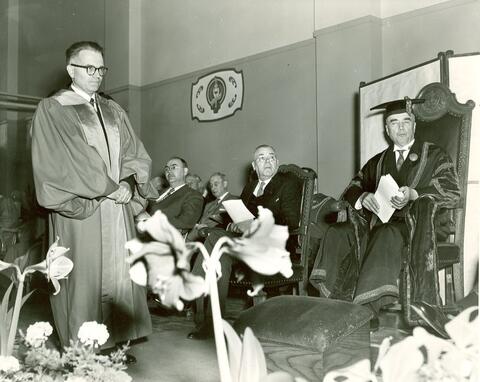
Zone du titre et de la mention de responsabilité
Titre propre
Honourary Degrees - Presentation - Dr. Gerhard Herzberg
Dénomination générale des documents
- Document graphique
Titre parallèle
Compléments du titre
Mentions de responsabilité du titre
Notes du titre
Niveau de description
Pièce
Cote
Zone de l'édition
Mention d'édition
Mentions de responsabilité relatives à l'édition
Zone des précisions relatives à la catégorie de documents
Mention d'échelle (cartographique)
Mention de projection (cartographique)
Mention des coordonnées (cartographiques)
Mention d'échelle (architecturale)
Juridiction responsable et dénomination (philatélique)
Zone des dates de production
Date(s)
-
1953 (Production)
Zone de description matérielle
Description matérielle
1 photograph : b&w-drymounted ; 25.0 x 20.2 cm
1 negative : b&w ; 12.5 x 10.0 cm
Zone de la collection
Titre propre de la collection
Titres parallèles de la collection
Compléments du titre de la collection
Mention de responsabilité relative à la collection
Numérotation à l'intérieur de la collection
Note sur la collection
Zone de la description archivistique
Nom du producteur
Historique de la conservation
Portée et contenu
F. Hedley Auld, University Chancellor, preparing to make presentation of an honourary Doctor of Laws degree to Dr. Gerhard Herzberg at Convocation ceremony held in Physical Education gymnasium.
Bio/Historical Note: Dr. Gerhard Heinrich Friedrich Otto Julius Herzberg was born in 1904 in Hamburg, Germany. After completing high school at the Gelehrtenschule des Johanneums, he continued his education at Darmstadt University of Technology. From 1928-1930 he carried out post-doctorate work at the University of Göttingen at the University of Bristol. In 1930 Dr. Herzberg was appointed Privatdozent (lecturer) and senior assistant in the Physics Department of the Darmstadt Institute of Technology. In August 1935 Dr. Herzberg was notified that he would be dismissed because his astrophysicist wife, Luise Herzberg, was Jewish, and he realized they would have to leave Nazi Germany. Dr. John Spinks, a visiting scientist from the University of Saskatchewan, arranged for the Herzbergs to come to Saskatoon. Gerhard Herzberg took up a guest professorship at the University of Saskatchewan, for which funds had been made available by the Carnegie Foundation. A few months later he was appointed research professor of Physics, a position he held until 1945. From 1945-1948 Dr. Herzberg was professor of spectroscopy at the Yerkes Observatory of the University of Chicago. He returned to Canada in 1948 and was made Principal Research Officer and shortly afterwards Director of the Division of Physics at the National Research Council. In 1955, after the Division had been divided into one in pure and one in applied physics, Dr. Herzberg remained Director of the Division of Pure Physics, a position he held until 1969 when he was appointed Distinguished Research Scientist in the recombined Division of Physics. Dr. Herzberg's main work concerned atomic and molecular spectroscopy. He was well known for using these techniques that determine the structures of diatomic and polyatomic molecules, including free radicals which are difficult to investigate in any other way, and for the chemical analysis of astronomical objects. Dr. Herzberg's most significant award was the 1971 Nobel Prize in Chemistry, which he was awarded "for his contributions to the knowledge of electronic structure and geometry of molecules, particularly free radicals.” During the presentation speech, it was noted that at the time of the award, Dr. Herzberg was "generally considered to be the world's foremost molecular spectroscopist."
Dr. Herzberg authored some classic works in the field of spectroscopy, including Atomic Spectra and Atomic Structure and the encyclopaedic four volume work: Molecular Spectra and Molecular Structure, which is often called the spectroscopist's bible. The three volumes of Molecular Spectra and Molecular Structure were re-issued by Krieger in 1989, including extensive new footnotes by Dr. Herzberg. Volume IV of the series, "Constants of diatomic molecules" is purely a reference work, a compendium of known spectroscopic constants (and therefore a bibliography of molecular spectroscopy) of diatomic molecules up until 1978. Dr. Herzberg was honoured with memberships or fellowships by a very large number of scientific societies, and received many awards and honourary degrees in different countries. Dr. Herzberg received an honourary Doctor of Laws degree from the University of Saskatchewan in 1953. The Herzberg Institute of Astrophysics (now called the NRC Herzberg Astronomy and Astrophysics Research Centre), in Victoria, British Columbia, was established in 1975. ‘Asteroid 3316 Herzberg’ was named after him in 1984. The Canadian Association of Physicists has an annual award named in his honour. The Herzberg Laboratories, housing the Physics and Mathematics/Statistics departments, is located at Carleton University. Gerhard Herzberg died in 1999 in Ottawa at age 94. The main building of John Abbott College in Montreal is named after him. A public park in the College Park neighbourhood of Saskatoon honours him. The NSERC Gerhard Herzberg Canada Gold Medal for Science and Engineering, Canada's highest research award, was named in his honour in 2000.
Zone des notes
État de conservation
Source immédiate d'acquisition
Classement
Langue des documents
Écriture des documents
Localisation des originaux
Disponibilité d'autres formats
Restrictions d'accès
Délais d'utilisation, de reproduction et de publication
Photographer:: Len Hillyard
Other terms: Researcher responsible for obtaining permission

